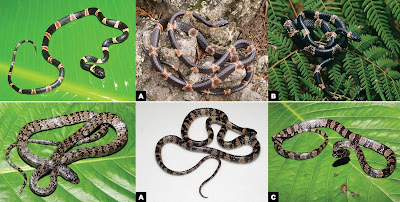Abstract
We describe two new species of Tropidodipsas related to the T. fasciata species group as defined by Kofron (1987), and provide morphological and molecular data to support the novelty of both species. A partial molecular phylogeny of the Mexican species of snail-eating snakes (Serpentes, Dipsadidae) is presented, and we discuss evolutionary relationships as supported by our molecular results. We analyze specific relationships of the new species described herein with their closest relatives. We present a distribution map for all species of Tropidodipsas and include photographs of living individuals of each species. Finally, we discuss other taxonomic changes based on our molecular phylogeny as well as conservation priorities of the new species.
Key Words: conservation, cloud forest, Geophis , Guerrero, Oaxaca, pine-oak woodland, Sierra Madre del Sur
 |
| Tropidodipsas tricolor sp. nov. Variation. Female from Municipio de Leonardo Bravo, Guerrero (A); Male from Municipio de Leonardo Bravo, Guerrero (B). Photos A–B by Peter Heimes. |
Tropidodipsas tricolor sp. nov.
Proposed standard English name: Tricolor Snailsucker
Proposed standard Spanish name: Caracolera tricolor
Diagnosis: Tropidodipsas tricolor sp. nov. is placed in the genus Tropidodipsas based on phylogenetic evidence (Fig. 6). It belongs to the Tropidodipsas fasciata group as defined by Kofron (1987) based on possessing a laterally compressed body, head distinctly wider than neck, protruding eyes of moderate to large diameter, vertebral and paravertebral scales not wider than other dorsal scales, 17 maxillary teeth, 18 dentary teeth, postmental scale absent. The species differs from all described species of Tropidodipsas based on the following combination of characters: (1) 15/15/15 rows of smooth dorsal scales with no enlarged vertebral row; (2) prefrontal broader than long, entering the orbit; (3) loreal square, equally long as high, not entering the orbit; (4) 183 ventral scales in males, 183 in females; (5) 78–79 divided subcaudals in males and 79 in females; (6) 19–22 reddish orange, light-edged bands on body, most with dark brown or black medial stippling, giving the snake a “tricolor” effect; 8 pale bands on tail; (7) ground color black or nearly so; (8) iris chocolate brown; (9) TL/SVL 0.31 in one male specimen, and 0.30 in one female specimen.
Distribution, habitat and ecology: This species appears to be restricted to moderate elevations in Sierra Madre del Sur from central Guerrero to western Oaxaca (Fig. 10). Habitats include cloud forest, mesic pine-oak woodland, tropical evergreen forest, tropical semi-deciduous forest and combinations of those assemblages (Brown et al. 2007). Known from 700–2200 m a.s.l., though most localities are from 1700–2200 m a.s.l. with the exception of the Sierra de Atoyac where it has been found at 700–1000 m a.s.l. in mesic tropical evergreen forest (Fig. 3A). Specimens were found at night on low or medium (1.5–3.0 m) vegetation, or dead on the road.
Etymology: The specific epithet tricolor refers to the tricolor pattern of the black dorsal coloration interspersed by light dorsal bands of cream and reddish orange.
Tropidodipsas papavericola sp. nov.
Proposed standard English name: Poppyfield Snailsucker
Proposed standard Spanish name: Caracolera amapolera
Diagnosis: Tropidodipsas papavericola sp. nov. is placed in the genus Tropidodipsas based on phylogenetic evidence (Fig. 6). It belongs to the Tropidodipsas fasciata group as defined by Kofron (1987) based on possessing a laterally compressed body, head distinctly wider than neck, protruding eyes of moderate to large diameter, vertebral and paravertebral scales not wider than other dorsal scales, 17 maxillary teeth, 22 dentary teeth, postmental scale absent. The species differs from all described species of Tropidodipsas recognized herein based on the following combination of characters: (1) 15/15/15 rows of smooth dorsal scales with no enlarged vertebral row; (2) prefrontal broader than long, not entering orbit; (3) loreal almost square, slightly longer than broad, not entering orbit; (4) 179–189 ventral scales in males, unknown in females; (5) 69–76 divided subcaudals in males, unknown in females; (6) 25–34 pale bands on body and 10–16 pale bands on tail; (7) 26–36 dark bands on body and 10–16 on tail, irregular with faded pale centers in adult individuals; (8) TL/SVL 0.30–0.35 in males, unknown in females; (9) iris dark chocolate-gray in life.
Distribution, habitat and ecology: This species appears to be restricted to moderate elevations in the Sierra Madre del Sur in central Guerrero in two distinct areas (Fig. 10). Habitats include cloud forest, mesic pine-oak woodland, tropical evergreen forest, tropical semi-deciduous forest and combinations of these assemblages. Known from around 1600–2200 m a.s.l. in the Sierra de Técpan de Galeana, Sierra de Atoyac and above Acapulco, in the foothills in the area encompassed between Acahuizotla and El Treinta. Specimens were found at night during the rainy season on low to medium (1.5–3.0 m) vegetation or crossing the road.
Etymology: The specific epithet papaver + cola refers to the living among poppy plants (genus Papaver) which are illegally planted throughout the range of this species for the extraction of opium gum.
Christoph I. Grünwald, Sarahi Toribio-Jiménez, Carlos Montaño-Ruvalcaba, Hector Franz-Chávez, Miguel A. Peñaloza-Montaño, Eduardo Y. Barrera-Nava, Jason M. Jones, Christopher M. Rodriguez, India M. Hughes, Jason L. Strickland and Jacobo Reyes-Velasco. 2021. Two New Species of Snail-eating Snakes of the Genus Tropidodipsas (Serpentes, Dipsadidae) from southern Mexico, with Notes on Related Species. Herpetozoa. 34: 233-257. DOI: 10.3897/herpetozoa.34.e69176












